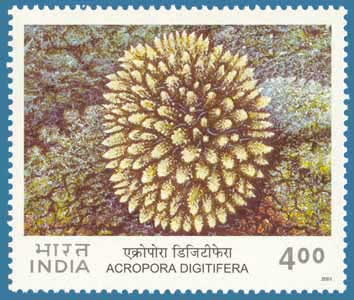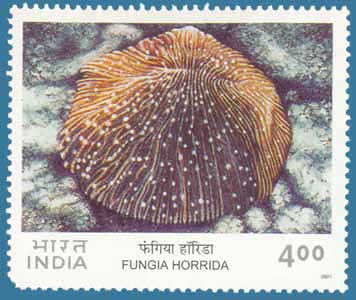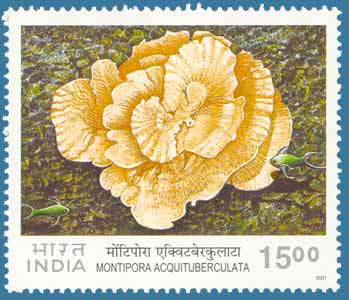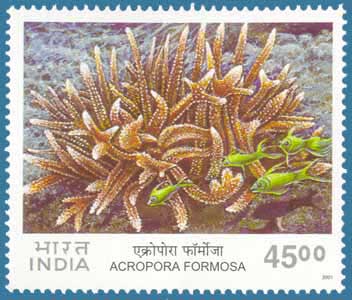|
|
Corals on Stamps
Coral reefs are among the greatest splendours of nature. They are the biggest structures built by living organisms. The extent of biodiversity supported by the coral reef is matched by no other ecosystem except the tropical rain forest. Interestingly, the vast reefs are built by tiny coral animals, often so small that they are invisible to the naked eye. What is commonly referred to as coral is actually the skeleton of the coral- animal, which is also called a polyp. Polyps generally multiply by the process of budding, whereby a portion of the parent pinches off to form a daughter polyp. All the daughter polyps along with their skeletons form a colony. Every coral colony begins as a minute skeleton of one single polyp, and keeps on growing by adding more and more individuals. Corals on the reefs have algae living inside their cells. The algal pigments are mostly responsible for the spectacular colours of the corals. The shapes, sizes and textures of the coral colonies vary enormously. There are at least 800 corals species, each one producing a distinct colony - rounded, flat, massive, leaf-like, brain-like and so on. The coral reef ecosystem is a diverse collection of species that co-exist in remarkable symbiosis. Sponges, sea anemones, worms, sea urchins, shrimps, crabs, octopuses, squids, clams, turtles, sea snakes and different types of fishes live in the reefs, adding to their colour and splendour. About 250 species of corals are known to exist in Indian reefs, a majority of them in the Andaman and Nicobar Islands. The other areas with well-grown coral reefs are the Gulf of Mannar, Gulf of Kachchh and Lakshadweep. Coral reefs provide livelihood to coastal communities by way of food and ornamental fishes, shells, algae and tourism. Coral reef organisms are also huge reservoirs of bioactive molecules of potential pharmaceutical value. Excessive human interference in the recent years in the form of coral mining, over harvest of fishes and other living resources, pollution of the sea etc. has led to a dramatic loss in the extent of Indian reefs. There is an urgent need to spread awareness about the economic and ecological importance of corals so that any further damage to this important ecosystem can be prevented. The corals which figure on the stamps are: Acropora digitifera, Fungia horrida, Montipora acquituberculata and Acropora formosa. _____________________________________________________
Acropora digitifera is a digitate coral having finger-like projections arising from the colony base. _____________________________________________________
Fungia horrida, commonly called the mushroom coral, is a single polyp and unlike other corals, is capable of limited movement. _____________________________________________________
Montipora acquituberculata or the velvet coral grows in the form of whorls. _____________________________________________________
Acropora formosa, also known as the staghorn coral, resembles antlers and is among the most beautiful organisms in the reefs. . Date of Issue: 2.8.2001
|
||||||||||||||||||||||||||||||||||||||||||||||||||||||



